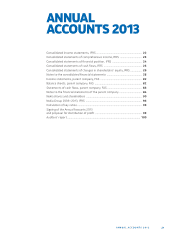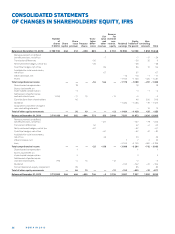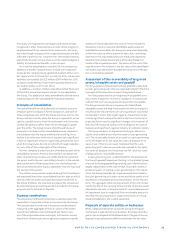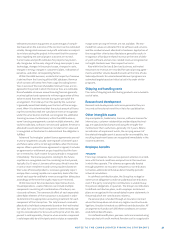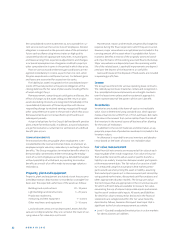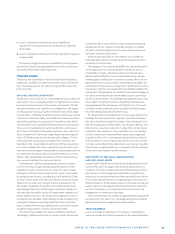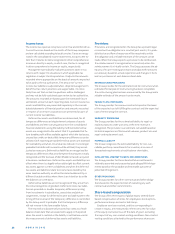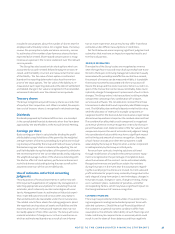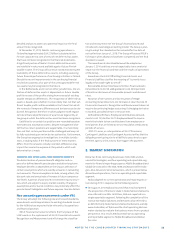Nokia 2013 Annual Report Download - page 32
Download and view the complete annual report
Please find page 32 of the 2013 Nokia annual report below. You can navigate through the pages in the report by either clicking on the pages listed below, or by using the keyword search tool below to find specific information within the annual report.NOKIA IN 2013
30
of the consideration received and the carrying amounts of
derecognized net assets attributable to the equity holders of
the parent and non-controlling interests of the disposed entity
or business, adjusted by amounts previously recognized in other
comprehensive income in relation to that entity or business.
Discontinued operations and assets held
for disposal
Discontinued operations are reported when a component of
an entity comprising operations and cash fl ows that can be
clearly distinguished, operationally and for fi nancial report-
ing purposes, from the rest of the entity is classifi ed as held
for disposal or has been disposed of, if the component either
() represents a major line of business or geographical area of
operations or () is part of a single co-ordinated plan to dis-
pose of a separate major line of business or geographical area
of operations. In the consolidated income statement, results
from discontinued operations is reported separately from
income and expenses from continuing operations and prior
periods are presented on a comparative basis. Cash fl ows for
discontinued operations are presented separately in Note. In
order to present the fi nancial eff ects of the continuing opera-
tions and discontinued operation revenues and expenses
arising from intra-group transactions are eliminated except for
those revenues and expenses that are considered to continue
after the disposal of the discontinued operations.
Non-current assets or disposal groups are classifi ed as as-
sets held for sale when the carrying amount is to be recovered
principally through a sale transaction rather than through con-
tinuing use. For this to be the case, the asset or disposal group
must be available for immediate sale in its present condition
subject only to terms that are usual and customary for sales
of such assets or disposal groups and the sale must be highly
probable. Non-current assets classifi ed as held for sale and
disposal groups are measured at the lower of their carrying
amount or fair value less costs to sell.
Foreign currency translation
FUNCTIONAL AND PRESENTATION CURRENCY
The fi nancial statements of all Group companies are measured
using functional currency, which is the currency of the primary
economic environment in which each of the companies oper-
ate. The consolidated fi nancial statements are presented in
euro, which is the functional and presentation currency of the
Parent Company.
TRANSACTIONS IN FOREIGN CURRENCIES
Transactions in foreign currencies are recorded at the rates of
exchange prevailing at the dates of the individual transactions.
For practical reasons, a rate that approximates the actual rate
at the date of the transaction is often used. At the end of the
accounting period, the unsettled balances on foreign currency
monetary assets and liabilities are valued at the rates of ex-
change prevailing at the end of the accounting period. Foreign
exchange gains and losses arising from statement of fi nancial
position items are reported in fi nancial income and expenses.
Unrealized foreign exchange gains and losses related to non-
current available-for-sale investments are recognized in other
comprehensive income.
FOREIGN GROUP COMPANIES
In the consolidated accounts, all income and expenses of for-
eign Group companies, where the functional currency is other
than euro, are translated into euro at the average monthly
foreign exchange rates. All assets and liabilities of foreign
Group companies are translated into euro at the year-end for-
eign exchange rates. Diff erences resulting from the translation
of income and expenses at the average rate and assets and
liabilities at the closing rate are recognized in other compre-
hensive income as translation diff erences within consolidated
shareholder’s equity. On the disposal of all or part of a foreign
Group company by sale, liquidation, repayment of share capi-
tal or abandonment, the cumulative amount or proportionate
share of the translation diff erences is recognized as income or
as expense when the gain or loss on disposal is recognized.
Revenue recognition
Revenues within the Group are generally recognized when the
signifi cant risks and rewards of ownership have transferred to
the buyer, continuing managerial involvement usually associ-
ated with ownership and eff ective control have ceased, the
amount of revenue can be measured reliably, it is probable that
economic benefi ts associated with the transaction will fl ow to
the Group and the costs incurred or to be incurred in respect
of the transaction can be measured reliably. When manage-
ment determines that such criteria have been met, revenue is
recognized.
NSN enters into transactions which involve multiple compo-
nents consisting of any combination of hardware, services and
software. Within these arrangements, separate components
are identifi ed and accounted for based on the nature and fair
value of those components and considering the economic
substance of the entire arrangement. Revenue is allocated to
each separately identifi able component based on the relative
fair value of each component. The fair value of each compo-
nent is determined by taking into consideration factors such
as the price of the component when sold separately and the
component cost plus a reasonable margin when price refer-
ences are not available. This determination of the fair value
and allocation thereof to each separately identifi able compo-
nent of a transaction requires the use of estimates and judg-
ment which may have a signifi cant impact on the timing and
amount of revenue recognized for the period. Service revenue,
which typically includes managed services and maintenance
services, is generally recognized on a straight-line basis over
the specifi ed period unless there is evidence that some other
method better represents the rendering of services.
Also at NSN, certain revenue is recognized from contracts
involving solutions achieved through modifi cation of complex



